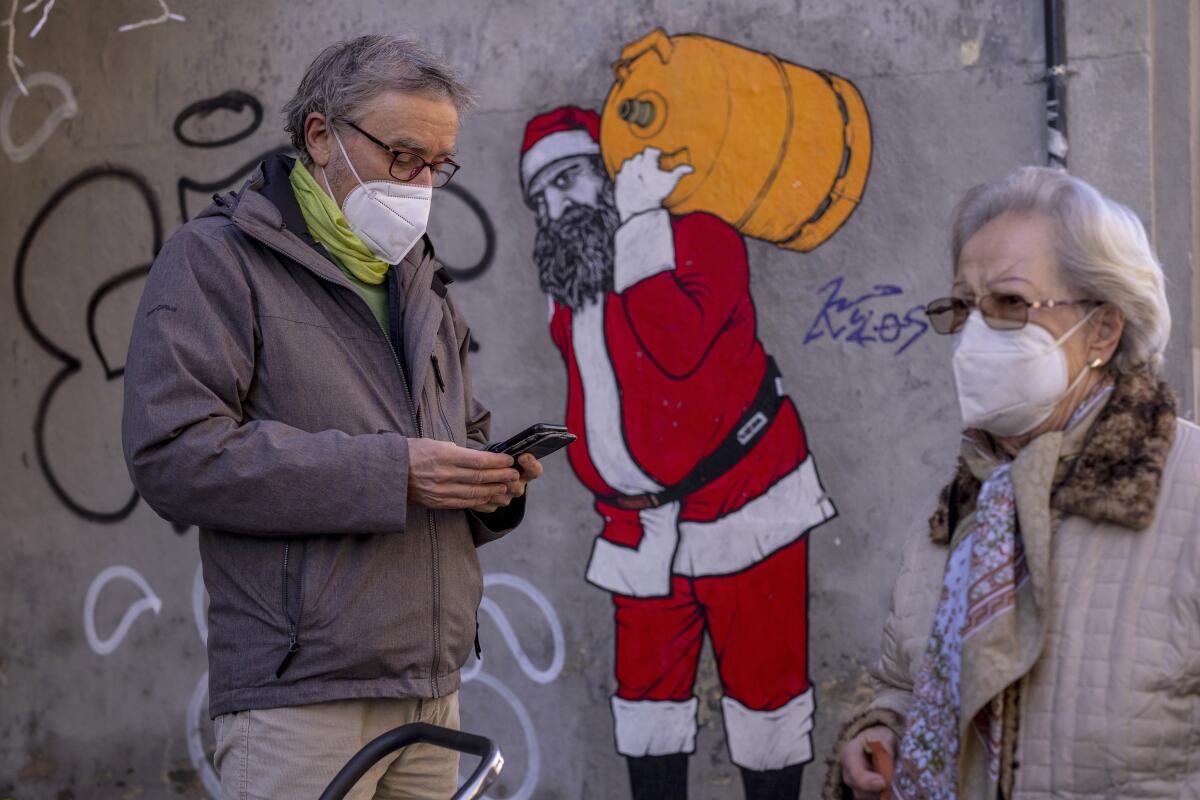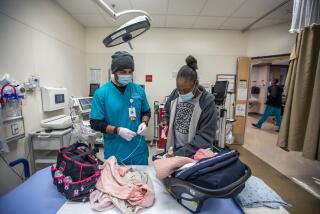Mask rules tightened in Europe during winter COVID-19 wave

- Share via
ROME — To mask or not to mask is a question Italy settled early in the COVID-19 outbreak with a vigorous “yes.” Now the onetime epicenter of the pandemic in Europe hopes even stricter mask rules will help it beat the latest infection surge.
Other countries are taking similar action as the more transmissible — yet, apparently, less virulent — Omicron variant spreads through the continent.
With intensive care units in Italy’s hospitals rapidly filling with mostly unvaccinated COVID-19 patients, the government announced on Christmas Eve that FFP2 masks — which offer users more protection than cloth or surgical masks — must be worn on public transport, including planes, trains, ferries and subways.
That’s even though all passengers in Italy, as of this week, must also be vaccinated or recently recovered from COVID-19. FFP2s also must now be worn at theaters, cinemas and sports events, indoors or out, and can’t be removed even for their wearers to eat or drink.
Italy reintroduced an outdoor mask mandate. It had never lifted its indoor mandate — even when infections sharply dropped in the summer.
On a chilly morning in Rome this week, Lillo D’Amico, 84, sported a wool cap and white FFP2 mask as he bought a newspaper at his neighborhood newsstand.
“[Masks] cost little money, they cost you a small sacrifice,” he said. “When you do the math, it costs far less than hospitalization.”
When he sees someone from the unmasked minority walking by, he keeps his distance. “They see [masks] as an affront to their freedom,” D’Amico said, shrugging.
Spain reinstated its outdoor mask rule on Christmas Eve. After the 14-day contagion rate soared to 2,722 new infections per 100,000 people by the end of last week — from 40 per 100,000 in mid-October — Prime Minister Pedro Sánchez was asked whether the outdoor mask mandate was helping.
“Of course, it is. It’s not me saying it. It’s science itself saying it because [it’s] a virus that is contracted when one exhales,” Sanchez said.
Portugal brought masks back at the end of November, after having largely dropped the requirement when it hit its goal of vaccinating 86% of the population.
Greece has also restored its outdoor mask mandate, while requiring an FFP2 or double surgical mask on public transport and in indoor public spaces.
This week, the Dutch government’s outbreak management team recommended a mask mandate for people over age 13 in busy public indoor areas such as restaurants, museums and theaters, and for spectators at indoor sports events. Those places are currently closed under a lockdown until at least Friday.
In France, the outdoor mask mandate was partially reinstated in December in many cities, including Paris. The age for children to start wearing masks in public places was lowered to 6 from 11.
Austrian Chancellor Karl Nehammer announced last week that people must wear FFP2 masks outdoors if they can’t keep at least two meters apart.
In Italy, with more than 2 million people currently positive for the virus in a nation of 60 million and workplace absences curtailing train and bus runs, the government also sees masks as a way to let society more fully function.
People with booster shots or recent second vaccine doses can now avoid quarantine after coming into contact with an infected person if they wear a FFP2 mask for 10 days.
The government has ordered shops to make FFP masks available for 85 cents. In the pandemic’s first year, FFP2s cost up to $11.50 — when they could be found.
Italians wear them in a palette of colors. The father of a baby baptized this week by Pope Francis in the Sistine Chapel wore one in burgundy, with matching tie and jacket pocket square. But the pontiff, who has practically shunned a mask in public, didn’t wear one.
On Monday, Vatican City mandated FFP2s in all indoor places. The tiny, walled independent state across the Tiber River from the heart of Rome also stipulated that Vatican employees can go to work without quarantining after coming into contact with someone who tested positive if, in addition to being fully vaccinated or having received a booster shot, they wear FFP2s.
Francis did appear to be wearing a FFP2 when, startling shoppers in Rome on Tuesday evening, he emerged from a music store near the Pantheon before being driven back to the Vatican.
In Britain, where Prime Minister Boris Johnson has focused on vaccination, masks have never been required outdoors.
This month, though, the government said secondary school students should wear face coverings in class. But Education Secretary Nadhim Zahawi said that rule wouldn’t apply “for a day longer than necessary.”
When the British government lifted pandemic restrictions in July 2021, turning mask wearing from a requirement to a suggestion, mask use fell markedly.
Nino Cartabellotta, president of the Bologna-based GIMBE foundation, which monitors healthcare in Italy, says Britain points to what can happen when measures like mask wearing aren’t valued.
“The situation in the U.K. showed that use of vaccination alone wasn’t enough” to get ahead of the pandemic, even though Britain was one of the first countries to begin vaccination, he said in a video interview.
Aritz Parra in Madrid, Barry Hatton in Lisbon, Portugal, Elena Becatoros in Athens, Jill Lawless in London, Sylvie Corbet in Paris, Mike Corder in The Hague and Frank Jordans in Berlin contributed to this report.
More to Read
Sign up for Essential California
The most important California stories and recommendations in your inbox every morning.
You may occasionally receive promotional content from the Los Angeles Times.










